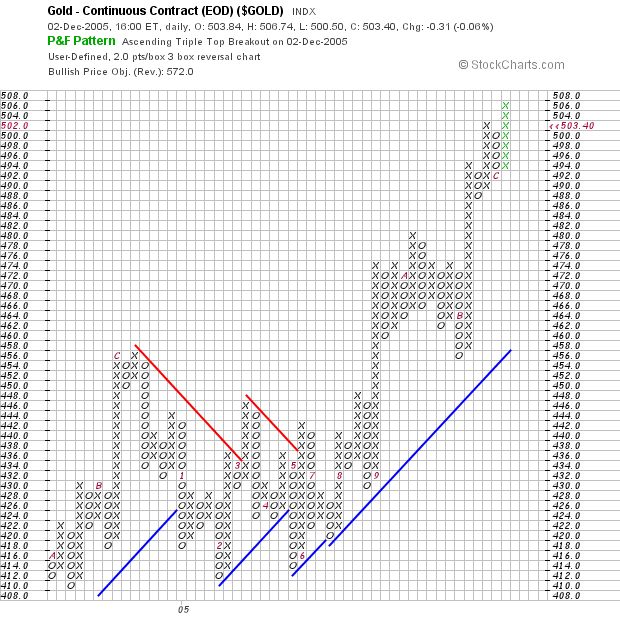|
|||
Rising gold is a political red flagRichard Russell
snippet
Reuters Dec. 2 -- New long term records were set for aluminium, copper, gold, lead, platinum, silver and zinc. Sugar also managed to nudge a nine- year high on Friday, showing it is not just the metal markets that are attracting investor attention.
Russell Comment -- And it's not only the metals that are surging. This from the front page of Saturday's Financial Times. "Collectors Drive Art Prices to New Highs. The last time art prices were this high, in 1990, Japan was an economic juggernaut and Japanese property prices, which underpinned the huge Japanese buying of impressionist works, were rising as if there was no tomorrow. This time, however, it is US collectors, including a generous sprinkling of hedge fund managers and property developers, and the newfound popularity of contemporary art which is pushing up art prices. The prices have risen 40 percent this year, passing the high of 1990 along the way." Another article in the December 3 Financial Times is headlined, "Big Spenders Like Big Stones." The stones they are talking about are diamonds. The article runs, "In the past the (diamond) trade has focused on pockets of wealth such as the Saudi royal houses. With billionaires springing up in China, India and Russia -- not to mention the US and Europe -- the trade is becoming fiercer than ever. Ten years ago there was a handful of active clients for stones at $10 million plus," says Nir Livnat, Steinmetz chief executive, "Now there are a couple of 100. The market for pieces between $1 million and $5 million was dominated by the Middle East. Now Americans are close to being the majority of buyers in that price range." Russell again -- What I'm saying is that due to massive paper creation by the central banks, the globe is swimming in liquidity. Never in world history has this much money been swishing about, and as a result -- prices of legitimate tangible articles are rising relentlessly. And, of course, this same hyper-liquidity has been driving stocks up on every stock exchange in the world. Stocks, real estate, diamonds, collectibles, art -- more and more paper is driving up the "paper-value" of all of these tangible items. And, of course, the issuance of massive amounts of paper serves to render debt easier to handle. Massive debt is basically deflationary. Inflation acts like morphine to a wounded man -- it eases the pain of debt. There's only one problem with this whole rather shameful procedure. The problem is that rising inflation (as signaled by rising gold) is a political liability. Voters see rising gold -- and they ask questions. Newspaper columnists start talking and analyzing -- and ultimately the voters know what's happening. They finally "get it" -- their money is worth less. You see, voters don't like the feeling of being robbed. Rising gold is a political red flag. And that's one of the great problems that governments and central banks have to deal with today. Up to recently, the central banks have been successful in holding the price of gold down. They've done this by periodic sales of gold, and by working with the gold banks in shorting gold. Furthermore, the gold mines themselves were shorting gold in order to lock in prices. Those machinations no longer seem to be working. Even worse for the anti-gold element, there are rumors that some of the central banks, fearful of holding too much paper, are actually buying gold. What about gold? The P&F chart below remains bullish. The November line of X's took gold from the 458 box to the 494 box. From there we saw a three-box consolidation and then a rise to the 502 box. Next a five-box correction to 492 and most recently a rise to a new high of 506. What next? The formation appears powerful and it would not surprise me to see gold rise to the 520 area before the next correction. The upside "count" for gold is now 572. A lot of so-called "professionals" and assorted "experts" have advocated trading gold -- buying weakness and selling strength. This is great in theory, but my experience during bull markets is that trading a primary bull trend usually leaves you out of the big moves -- and waiting for another decline so you can re-enter. I think that's about what has happened to those who have sold out their gold on strength, but then have failed to get back in -- consequently, the gold-train has left without them. I've advocated staying with your gold position -- and if you do anything, you simply ADD to your position on gold weakness. At least that's what I've done, and so far, it's been the way to go -- at least it's worked for me.  more follows for subscribers... December 6, 2005
© Copyright 1958-2014 Dow Theory Letters, Inc. Richard Russell began publishing Dow Theory Letters in 1958, and he has been writing the Letters ever since (never once having skipped a Letter). Dow Theory Letters is the oldest service continuously written by one person in the business. He offers a TRIAL (two consecutive up-to-date issues) for $1.00 (same price that was originally charged in 1958). Trials, please one time only. Mail your $1.00 check to: Dow Theory Letters, PO Box 1759, La Jolla, CA 92038 (annual cost of a subscription is $300, tax deductible if ordered through your business). |
